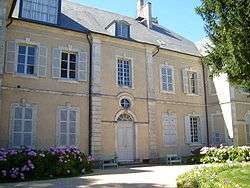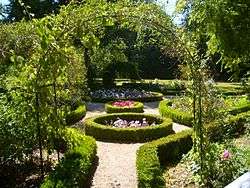House of George Sand




The House of French writer George Sand (1804–1876) is a writer's house museum in the village of Nohant, in the Indre Department of France. It was purchased by the French state in 1952, and preserved because it was where George Sand wrote many of her books and hosted many of the most important artists and writers of her time, including Frédéric Chopin, Balzac, Turgenev, and Delacroix. The writer and her family are buried in a small cemetery between the garden and the village church. The gardens are classified by the French Ministry of Culture as among the Notable Gardens of France. The house is open to the public, and is managed by the Centre des monuments nationaux.
History
The village of 'Nohan' is mentioned in French chronicles as early as 1228. A fortified manor house stood on the site, and was reconstructed between 1450 and 1452. Two of the original towers are part of the farm of the present chateau.[1] In 1767 the land and house was purchased by Pierre Pearron, who reconstructed the manor in its present form. It was sold in 1793, during the French Revolution, to Madame Dupin de Francueil, the illegitimate daughter of the French military hero Marechal Maurice de Saxe, and granddaughter of August II the Strong, the King of Poland, grandmother of George Sand, who laid out the gardens and built the main stairway.
In 1808 Aurore Dupin (the future George Sand), then just four years old, came to live with her grandmother after the accidental death of her father, Maurice Dupin, an officer in the French army.
Aurore Dupin's grandmother was not happy with what she considered the excessive exuberance and free ways of the child, and sent her to a convent. When Aurore was 16 her grandmother was paralyzed by a stroke, and she returned to Nohant to take care of her. When her grandmother died in 1821, Aurore received the house as an inheritance. The following year, she married Casimir Dudevant, who was nine years her senior. They had two children, Maurice (born 1823) and Solange (born 1828).[2]
In 1830, Aurore fell in love with Jules Sandeau,[3] and left her husband to move to Paris. There she wrote two novels, Indiana and Lélia under the name George Sand, which made her famous. In her absence her husband took possession of the house. She regained it after a lawsuit, and moved back into the house in 1837.
From 1837 until her death in 1876, Sand spent long summers, usually from May until November, at the house, where she entertained many of the most famous artists of the time, including composer Franz Liszt, writers Honoré de Balzac and Gustave Flaubert, and painter Eugène Delacroix. From 1839 until 1847, Frédéric Chopin lived with her in the house, writing his Fantasie in fa Minor, the Sonata Funebre, the two Nocturnes, Op. 37, and the four Mazurkas, Op. 41.[4]
Many of her most famous novels, including Consuelo, La Mare au Diable, and Le Meunier d'Angibault, were written in the house, and most of her novels are set in the Berry countryside and villages around Nohant.[5]
After the death of George Sand, the house passed to her son Maurice Dudevant (1823–1889). The house remained in the family until the death of Sand's granddaughter, Aurore Dudevant (1866–1961). It was classified as a National Historical Monument of France in 1952,[6] and was opened to the public in 1961 as Maison de George Sand à Nohant.
Sources and Citations
- ↑ La Maison de George Sand a Nohant, Anne-Marie de Brem, Editions du Patrimoine, Centre des Monuments Nationaux
- ↑ To mark the births of the children, George Sand planted two cedar trees in front of the house. The trees are still there today.
- ↑ She wrote her first book in collaboration with Sandeau, and took her famous pseudonym from his last name
- ↑ The panels which George Sand installed to muffle the sound of Chopin's piano can still be seen.
- ↑ See Anne-Marie de Brem, La Maison de George Sand at Nohant
- ↑ "Monuments historiques: Domaine de Nohant ou domaine de George Sand". Ministère de la culture et de la Communication – Mérimée database. Retrieved 23 March 2016.
External links
- Maison de George Sand à Nohant - official site
Coordinates: 46°37′30″N 1°58′32″E / 46.62500°N 1.97556°E